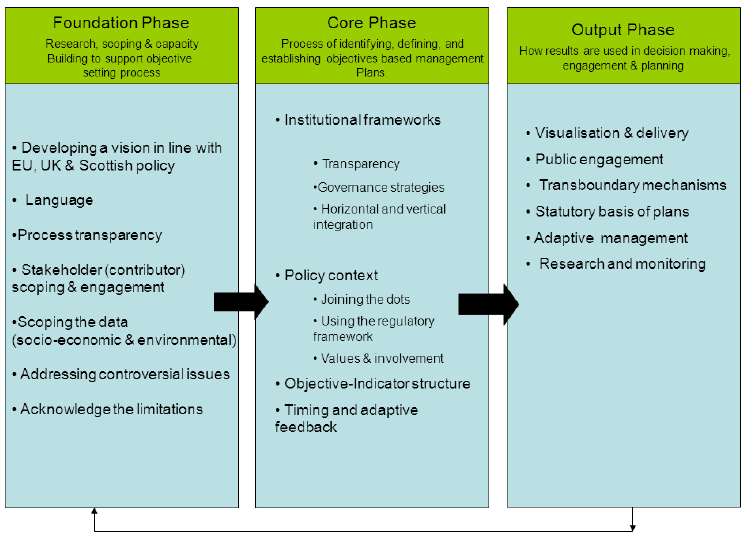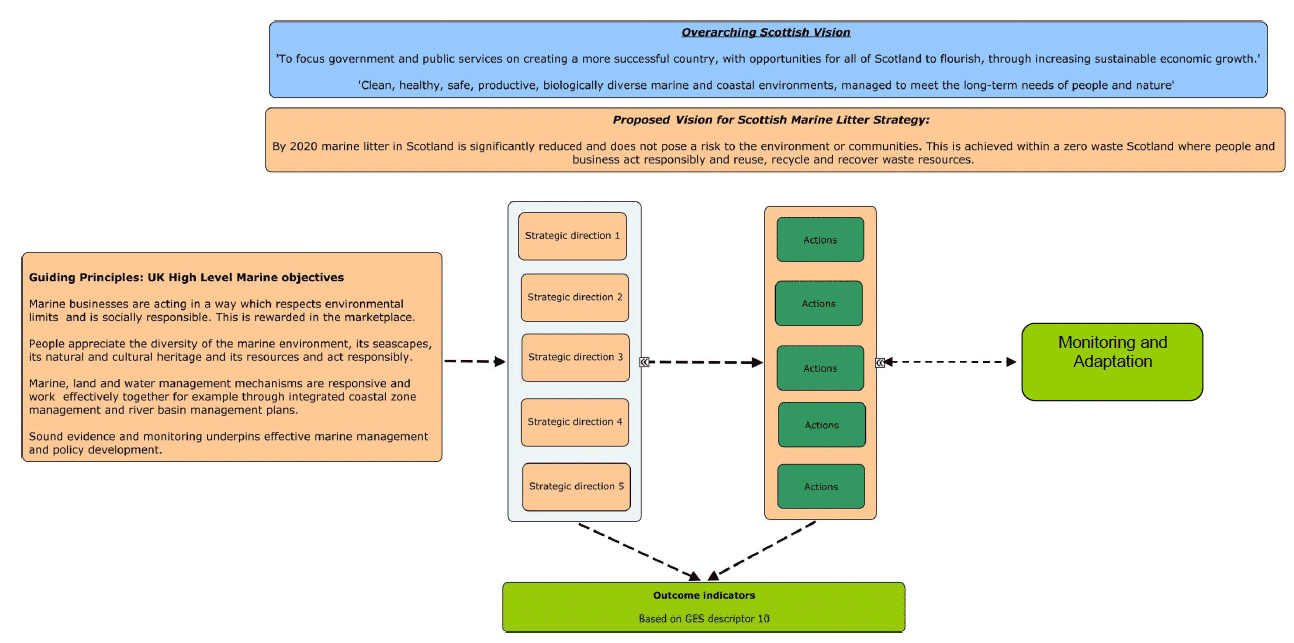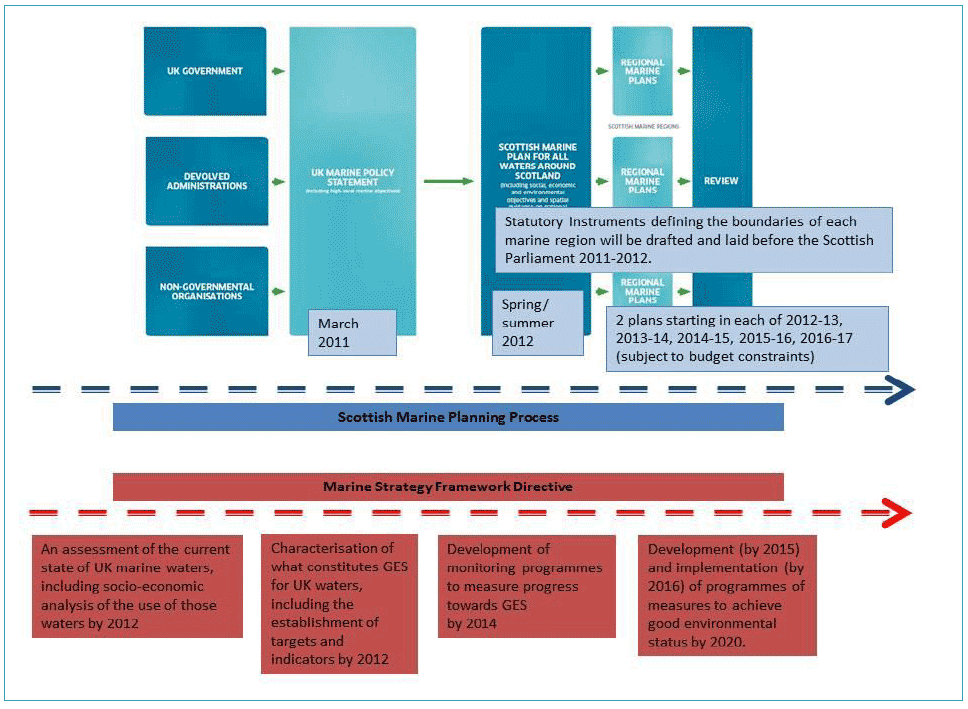Marine litter issues, impacts and actions
A study that will contribute to developing a marine litter strategy for Scotland’s seas in light of the Marine (Scotland) Act 2010.
11 Establishing Objectives and Targets for a Marine Litter Strategy
11.1 Overview
In this chapter we will introduce:
- A 'best practice' process for identifying objectives and management planning;
- A draft vision and set of strategic objectives to be linked to specific actions based upon existing initiatives , the litter workshop and policy obligations;
- A series of options for developing and improving policies and cost/benefit summary.
11.2 Establishing an objective setting process for marine litter: A best practice approach
In order to present a coherent framework, we will draw upon previous research for the Scottish Government that highlighted a 'best practice' approach to developing objectives for the national marine plan. 1 We have rescaled this approach to inform the development of a marine litter strategy to inform the process of setting objectives, actions and indicators that inform and guide policy actions.
We have two aims for this work 1) emphasising a transparent, inclusive and integrated approach that supports the development of effective objectives that work in practice, and 2) an initial assessment of what the objectives and actions could like to promote further discussion on route to a Scottish Marine Litter Strategy.
Figure 11-1 below highlights the best practice framework. Overall, the system is one that can be used to guide the objective setting and management process. It occurs through a series of consecutive stages that mimic the policy cycle, from pre-planning and engagement to institutional design and to the application in decision making with adaptive feedback loops.

Figure 11 ‑ 1 The Best Practice Framework for Objective Based Management Systems
The process highlights three key phases:
The Foundation Phase develops the groundwork for establishing an objectives-based management system that brings together research, scoping, and capacity building to support the objective-setting process.
The Core Phase identifies and sets the process of identifying, defining, and establishing objectives indicators and planning structures within an appropriate policy context.
The Output Phase: how the results of the process are used to improve decision-making, stakeholder/contributor engagement, and planning.
11.3 The Foundation phase: research, scoping and capacity building to support the objective setting process
11.3.1 Setting the vision
There are currently several inter-related visions for the marine environment and waste management which are relevant to a Scottish Marine Litter Strategy. For example:
- The vision for the Scottish Government is "To focus government services on creating a more successful country with opportunities for all of Scotland to flourish through increasing sustainable economic growth."
- The Scottish Government marine vision is " clean, healthy, safe, productive and biologically diverse marine and coastal environments managed to meet the long term needs of people and nature"
- The MSFD aims to achieve sustainable management of the seas of Member States by present, and for future, generations. 2 For marine litter the descriptor has been proposed (in draft form) by a DEFRA MGES working group 3 as:
- Litter and its degradation products currently present in, and entering into, UK waters is reduced over time and does not pose a significant risk to marine life at the population level, either as a result of direct mortality or by way of indirect impacts such as reduced fecundity and bioaccumulation within food chains.
- Litter currently present in, and entering into, UK waters does not pose a direct or indirect unacceptable risk to human welfare and does not lead to significant detrimental economic impacts for industry and coastal communities.
- The Zero Waste Plan sets the vision of "To achieve a zero waste Scotland, where we make the most efficient use of resources by minimising Scotland's demand on primary resources, and maximising the reuse, recycling and recovery of resources instead of treating them as waste."
- From the UK and Devolved authority High Level Marine Objectives: 4
- Marine businesses are acting in a way which respects environmental limits and is socially responsible. This is rewarded in the marketplace.
- People appreciate the diversity of the marine environment, its seascapes, its natural and cultural heritage and its resources and act responsibly.
- Marine, land and water management mechanisms are responsive and work effectively together
- Sound evidence and monitoring underpins effective marine management and policy development.
From the range of 'visions' compiled here, the project team have suggested a vision that mixes the key elements of the GES descriptor and the Zero Waste Plan. The term 'risk' implies a precautionary approach to the management of marine litter, avoiding serious impacts to ecological systems and human welfare before they occur. Further clarification of the vision in a marine litter strategy should quantify and define the concept of risk to avoid misinterpretation of this term. At a minimum this should be in parallel with the indicators used to assess GES in Scottish waters.
By 2020 marine litter in Scotland is significantly reduced and does not pose a risk to the environment or communities. This is supported by our vision of zero waste society, where people and businesses act responsibly and reuse, recycle and recover waste resources.
11.3.2 Language
It is important to consider the message to be conveyed, and to make sure that the language accurately reflects this message. If the public and key stakeholders receive confused signals this breeds mistrust from the very start. Linguistic foundations must be clear and transparent.
11.3.3 Process transparency
" There must be confidence in the planning process amongst all of
the variousstakeholders. This is very important but also very timeconsuming."
- ESSIM Forum, Canada.Transparency needs to exist at the level of the process itself, as well as in the vision and objectives produced by the process. The selection of the final vision, the engagement of contributors (stakeholders) from individuals to the private sector, and the articulation and evaluation of the objectives and action plan must be transparent and credible. Linked to this concept is that the Scottish Marine Litter strategy must be seen to be pragmatic and action orientated and avoid being labelled as 'just another plan'.
Linked to the concept of transparency is the concept of acknowledgment of limits. We are in a phase of government where public sector programs are competing for scarce and limited resources. There is an increasing pressure to do 'more with less'. While this calls for innovation, networking and capacity building to address the challenges, we strongly endorse that the actions in the proposed litter strategy are supported by appropriate resources and novel funding strategies.
As noted in the legislative review, jurisdictional issues are a complex but realistic issue within the proposed strategy. The analysis highlights that many objectives and outcomes can be achieved within Scottish jurisdiction, as management of waste and litter is predominantly a devolved activity. However, several legislative instruments and management regimes remain in the area of UK competence (e.g. Shipping, EU relations and OSPAR) and will require cooperation and integration of policy and management initiatives between devolved authorities. On issues such as port reception facilities and shipping management, cooperation between ports and agencies in different regions and countries is critical in terms of effective monitoring and enforcement.
11.3.4 Stakeholder engagement
Afford (and be seen to afford) equal opportunity to all members of the public to contribute to the planning process.
The concept of the "stakeholder" is increasingly viewed (by stakeholders) as a 'tick box' exercise in the implementation of policy. The term was coined to reflect individuals or groups with a particular interest (or stake) in a particular issue, and to engage and encourage them to contribute their views or to hear the views of other stakeholders. We have found that the term over time has lost some of its capital as a concept. Therefore the concept and the associated process need an innovative and refreshing start to focus on culture change when it comes to litter management. We suggest the term contributor that aims to promote inclusiveness, participation and collaboration. This should be backed by forward thinking and practical actions that can achieve real gains in achieving the GES targets. In addition this is an important aspect of building in the cultural change necessary to drive changes in values and behaviour for seeing waste as a resource (identified in the EU Waste Directive and Zero Waste Plan).
11.3.5 Scoping Data
For marine litter, the availability and cost of obtaining data for mapping out the problem on the coast, water column, and the seabed is a major scientific undertaking. Marine Science Scotland is pursuing monitoring efforts in support of achieving GES and will be expanding monitoring programs. OSPAR is calling for an increase in the scope of beach monitoring and identifying gaps in the data in terms of impacts from maritime industries. In addition, the Zero waste Plan intends to review the success of measures to influence waste behaviours, including incentives, and encourage the development of schemes to drive reductions in waste and improvements in recycling performance.
Data requirements for new objectives and associated indicators are often a challenge to their effectiveness. New data requirements, especially in the economic and social dimensions, and at the appropriate scale, should be identified and resourced by collaboration with research providers.
11.4 Core Phase: The process of identifying, defining and establishing objectives-based management plans
Objectives and management systems must be established through appropriate, accessible and transparent institutional frameworks. Institutional frameworks must reflect needs and core values of government and electorate.
11.4.1 Institutional Framework and Policy context
While the above statement appears fairly obvious, it is important to ensure that any objective system sits within the prevailing policy context. This requires political and parliamentary support, and reflection of the needs of the community. When it comes to marine litter and the zero waste approach, social change is a major element of the process across individual and corporate domains. The recent Scottish Environmental Attitudes and Behaviours Survey (Scottish Government Social Research 2009) 5 shows that societies respond differently to environmental damage and change. According to Professor Jan Webb, core values, which are embedded in political, economic and social institutions, lie behind these responses and it is these that need to be addressed when delivering litter awareness campaigns and fostering a sense of marine and coastal citizenship.
The objectives system should integrate with the prevailing regulatory and policy framework that defines its purpose, structure, and role in decision making.
While the high level strategic action in the marine litter strategy will inform, but not prescribe local level actions, it is important that the strategy meshes with the regulatory framework and is able to be enacted through appropriate instruments. Institutional frameworks establish the governance context for the objective based management system. They establish how decisions are made, how the contributor groups are structured, the role of advice bodies, and the links to central and local government.
Integration means 'joining the dots across legislation and policy instruments' and is endorsed in the UK High Level Marine Principles. There are several connections to consider when addressing the problem of marine litter. The most obvious is the accumulation of litter from terrestrial and marine sources at the coastal interface and the range of legislative instruments available to deal with the issue. While this appears common-sense, it is questionable that the current legislative and policy system is suitably integrated to address the marine litter problem. Integration should be considered in terms of the effectiveness of individual instruments such as the Marine (Scotland) Act or the Zero Waste Policy and in terms of how these instruments aggregate upwards and influence initiatives at the UK and EU levels, e.g. the MSFD and regional cooperation on a regional sea basis to ensure Good Environmental Status.
The proposed Scottish Marine Litter Strategy is an opportunity to provide a roadmap and integration of a range of statutory and non-statutory instruments that can be brought to bear on the marine litter problem. An important principle when constructing the strategy is to consider duplication of effort, and to ensure that the most efficient regulatory path is taken to address the problem. In particular we observe the Marine (Scotland) Act 2010 and the Climate Change (Scotland) Act 2009 as key overarching mechanisms to deliver a Marine Litter Strategy, supported by some aspects of the Zero Waste Plan.
Other factors to consider:
- Centralisation versus a regional model for decision making and coordination;
- Mechanisms to integrate across sectors and communities of interest
- Mechanisms to coordinate across departments and Directorates ensuring regulatory instruments are sufficiently integrated (e.g. WFD and MSFD)
- Coordination down to local government and up to EU
- Adequate community involvement (not just the usual suspects)
11.4.2 Objectives/Indicator structure
The implementation of objectives, actions and indicators is a complex task requiring resources, cooperation, commitment and consensus. The articulation of objectives, actions and indicators is an essential component of system development, and one that takes resources and time. Objectives define a series of 'position statements' or articulated policy goals, are implemented by actions, and performance measured by a suite of indicators and performance measures. Objectives and indicators can be observed to implement four overall functions:
- Linking objectives to management to improve decision-making;
- Reporting and assessment;
- Building consensus and participation; and
- Forming linkages and integrating scientific and policy disciplines.
Objectives, actions and indicators are a package - without succinct and clear objectives, actions to be implemented and targets to assess performance, a strategy can be interpreted in many ways. In practice, the challenge is to drive consensus around the measures, and ensure that decision making and monitoring align with the strategy over time. The process must be politically feasible and pragmatic in order to implement the government's agenda for marine governance. In addition the process should be inspirational, setting ambitious targets and stretch goals that drive innovation, for example ambitious recycling and recovery targets and reduction from source.
We have suggested a framework based on the articulated vision that links a series of strategic directions to a series of actions. The directions and actions are informed by the UK High Level Marine Objectives as agreed by all UK authorities. Under the actions, the performance of the system will be assessed by a series of outcome indicators as specified in the DEFRA workshop on achieving GES. The framework is elaborated in Chapter 12.
11.5 Timelines
The Scottish Marine litter Strategy should mesh with key policy timelines as indicated in the Scottish marine planning process and the Marine Strategy Framework Directive (Figure 11-3). We recommend that 2011 will be an appropriate time to develop and consult on a Marine Litter Strategy, with implementation in 2012 synchronising with key outputs such as the Scottish Marine Plan and the establishment of targets and indicators for the determination of Good Environmental Status for UK waters. This will enable elements of the strategy to be included in the regional marine planning process.

Figure 11 ‑ 2 Proposed Framework for the Scottish Marine litter Strategy

Figure 11 ‑ 3 Timelines for implementation (Potts, T., 2011)
11.6 Output Phase: How results are used in decision-making, engagement, planning
11.6.1 Visualisation and Public Engagement
The communication of indicator results is a critical phase often neglected in many initiatives. To facilitate their use within decision-making, and to make the results accessible, a strategy of aggregation and/or visualisation is critical. While aggregation refers to mathematically based methods that condense many scores into a few compact indices, visualisation refers to the means of getting the indicator message across to the relevant stakeholders.
There is a demand to be innovative and forward looking when it comes to engaging communities and user interests. The usual way of looking at public/stakeholder/ engagement in the context of the marine environment is to ensure all relevant contributors are identified and have a voice, with a view to fostering a sense of ownership and stewardship over the coastal environment and its resources. This is very important and very necessary. However, there is another aspect to stakeholder/contributor engagement. Often there are interested individuals and groups in the general public who already have a strong sense of ownership and stewardship and who want and need their voices to be heard in this regard. This can be viewed as an asset in that the contributor's commitment and knowledge can be harnessed to help develop and deliver relevant aspects of the proposed plan. It is a matter of getting the balance right between representation and effectiveness.
11.6.2 Transboundary mechanisms
A Scottish Marine Litter Strategy should account for transboundary influences. The legal analysis highlights that many objectives and outcomes can be achieved within Scottish jurisdiction, as management of waste and litter is predominantly a devolved activity. When it comes to the maritime sector several activities relating to marine litter are devolved or executively devolved (such as Ports) where they integrate with the land system. However, several legislative regimes are in the area of UK competence, and will require cooperation. For example, while ports are a devolved activity, shipping and oil and gas are regulated in a UK context. In addition, the legal analysis identifies that a strategy will play an important role in delivering EU MSFD targets and promoting regional cooperation through OSPAR.
11.6.3 Commitment to adaptive management
Adaptive management aims to increase resilience to unforeseeable change in an ecosystem and recognises that the level of scientific uncertainties in social and ecological systems can prevent the making of long-term management decisions. The adaptive management process involves:
- An agreed long-term vision for the future state of the ecosystem;
- The establishment of pragmatic shorter-term operational objectives;
- Progress review supported by scientific monitoring; and
- Information feed-back loops.
As research reduces uncertainty, the process begins again and the operational targets (and long-term vision) may be revised on a regular timetable. The close involvement of all stakeholders is crucial to the success of the adaptive management process.
Contact
There is a problem
Thanks for your feedback